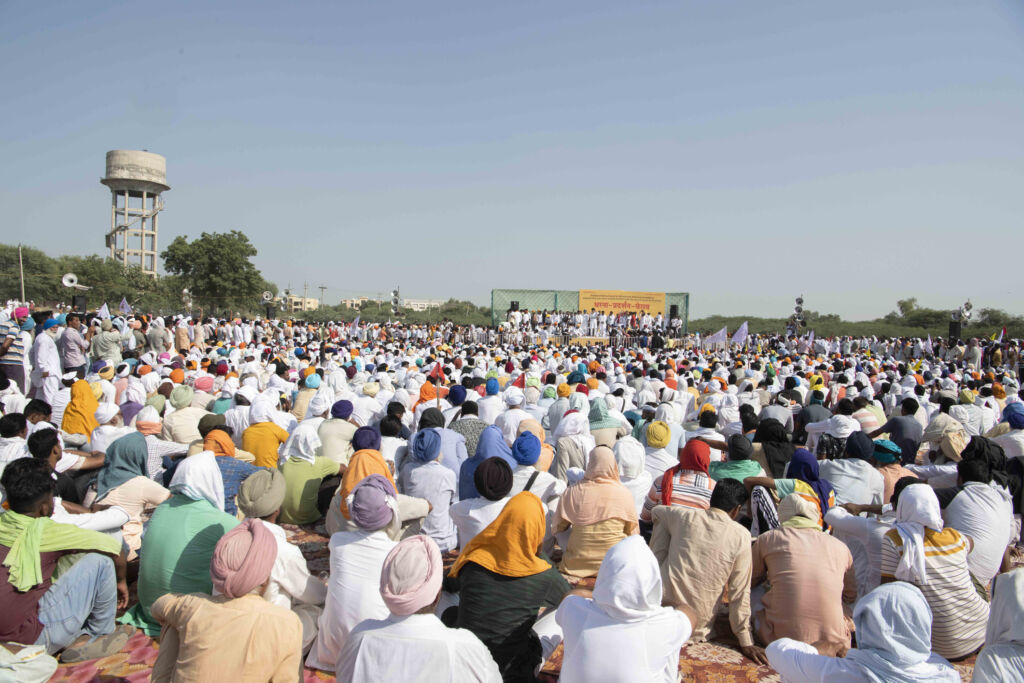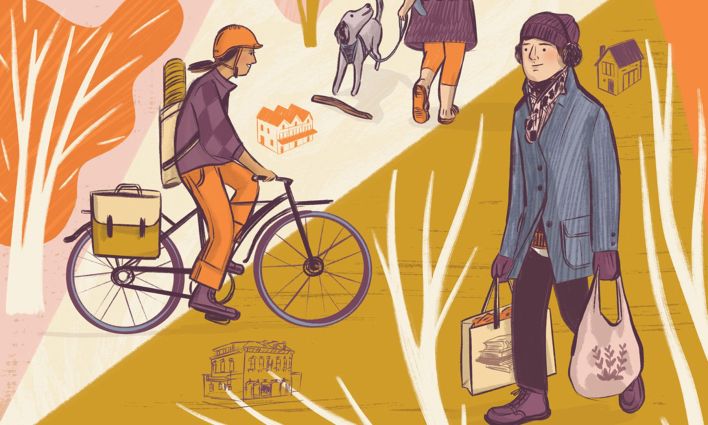IN RECENT WEEKS, the farmers’ protests in India have become an international cause célèbre, attracting support from Rihanna, Greta Thunberg, Susan Sarandon and more. The women farmers at the front lines of the protests were featured on the cover of Time magazine in early March. One month prior, in Canada, labour and community organizations took out a full-page advertisement in the Toronto Star voicing their support of the farmers. Despite only recently gaining attention in the West, the farmers’ protests in India have been ongoing for over half a year, making them, by Time magazine’s estimate, “the world’s largest ongoing demonstration and perhaps the biggest in human history.”
About 41% of India’s 501 million-strong workforce is involved in agriculture. The 300,000 protesting farmers—mainly from Punjab, Haryana and Uttar Pradesh states—are demanding the repeal of three laws passed by the Hindu supremacist, neofascist and neoliberal government of Prime Minister Narendra Modi and his Bharatiya Janata Party (BJP) in September 2020. These laws open up India’s agricultural sector to corporate domination by eliminating the officially guaranteed minimum support price (MSP) to farmers for their crops and the government-controlled markets (mandis) that the crops have been sold in. The laws also undermine the agricultural produce marketing committees (APMC) and state procurement. These safeguards have protected India’s farmers from total exploitation by the free market for decades.
Under these new laws, farmers sell directly to corporations, which in India often assert monopoly control over markets and so can dictate low prices to farmers. This new process could result in small and marginalized farmers—who make up 85% of all of India’s farmers—losing their land to corporations. The three laws, which were passed without any consultation with farmers and in violation of parliamentary procedure, are so blatantly pro-agribusiness that they even forbid farmers from suing corporations, leaving the former completely at the mercy of the latter.
As farmer Sukhdev Singh Kokri told the BBC, “This is a death warrant for small and marginalized farmers. This is aimed at destroying them by handing over agriculture and market to the big corporates. They want to snatch away our land. But we will not let them do this.”
The government’s reaction to the protests has been suppression. It has shut down the internet in the area of the protests and repeatedly pressured Twitter to suspend accounts critical of the BJP government. In February, Twitter cooperated by suspending 500 accounts, later restoring some accounts associated with the protest, including the enormously popular Kisan Ekta Morcha and Tractor2Twitr. On the ground, protestors are met with government-backed violence including tear gas, water cannons and police barricades, and alleged state-sanctioned attacks on farmers. So far, 248 have died from state-sanctioned violence in response to the protests, as well as from suicides and the cold weather in December.
Prior to these new laws, farmers in India had already been suffering profoundly for three decades due to the steady withdrawal of official supports. In 1992, neoliberalism became government policy in India. Since then, 330,000 farmers have died by suicide. Modi’s new laws have now pushed farmers completely to the edge.
“The farmers’ agitation has enormous transformative potential for Indian society,” Prabhat Patnaik tells me. Patnaik is Professor Emeritus at Jawaharlal Nehru University in New Delhi and a leading Indian expert in economics. For Patnaik, the farmers’ movement is “a reminder” of the anti-colonial Indian struggle for independence against British rule, which sought to build “an egalitarian democratic society” that would improve the peoples’ “conditions of life.” Patnaik emphasizes that “this conception alone can enable India to survive as a nation” and that the farmers’ movement “is a struggle for the revival of the life of the nation.”
Satya Sagar agrees with Patnaik when he tells me that “the farmers’ movement is a turning point in the battle against the fascist designs of the upper caste Hindu supremacists [led by Modi and the BJP] and truly historical—on par with the Indian struggle for freedom from British colonialism.” Sagar is a prominent leftist Indian journalist and associate editor of the online magazine Counter Currents.
The continued neocolonization of India by corporations is, however, dependent on the BJP maintaining its success through its divide-and-rule policy of vilifying minorities, which is how it wins elections.
The rule of Modi and the BJP, which won their second majority in the 2019 elections, is characterized by blatant discrimination against and violent attacks on India’s minorities. Discrimination has been most acute for the 200 million Muslim Indians who collectively make up 14% of the country’s population. At the same time, the BJP promotes a culture of Hindu domination—Hindus make up 84% of India’s population—particularly that of upper castes, while advancing an agenda to ensure corporate control over the Indian economy. Modi uses neofascism to spread neoliberalism.
As Patnaik argues in a recent interview: “Neofascism is the culmination of the global pursuit of neoliberalism which greatly widened income and wealth inequalities in every country and led to an absolute immiseration of vast masses of the working people in [countries] like India.” To enforce such massive deprivation, “the corporate-financial oligarchy forms an alliance with neofascist elements to shift the discourse away from conditions of material life towards vilifying the ‘other’, typically a hapless religious and ethnic minority.”
Sagar describes the particular corporate interests that Modi is serving in the farmers’ case. “Modi is nothing more than a facade for the designs of large corporations…The main beneficiary of the new farm laws is expected to be Mukesh Ambani, India’s [and Asia’s] richest business tycoon [and Modi’s biggest funder].” Ambani has received US$21 billion in investments “from Facebook, Google, the Saudi and Abu Dhabi sovereign funds. This was possible mainly because Ambani is known to be close to the current regime and investing in his business is expected to ensure profitable returns.”
Sagar points out that “Facebook is the biggest investor in Ambani’s Jio Platforms, that owns both Jio—India’s largest mobile network—and Jio Mart which hopes to dominate the country’s fast-growing e-groceries market. The plan is for Ambani’s telecom empire to join forces with Facebook’s messaging service WhatsApp, which has over 400 million users in India, to expand Jio Mart’s consumer base.
“While e-groceries companies like Jio Mart will control purchase, processing and retail of food products, large agribusinesses are likely to enforce everything from choice of crops to selection of seeds, fertilizers and pesticides. Digital payment services—that include the Facebook-owned WhatsApp—will provide credit, finally reducing farmers to the status of wage earners permanently at the mercy of whimsical corporate executives and investors. The new farm laws are meant to facilitate the growth of such ventures and without this legal framework no foreign investor will want to put money in India.”
Sagar calls Amazon, Facebook, Google and Walmart successors of the British East India Company, which along with the British Crown, colonized and looted India for 200 years, condemning it to an abyss of poverty.
The continued neocolonization of India by corporations is, however, dependent on the BJP maintaining its success through its divide-and-rule policy of vilifying minorities, which is how it wins elections. But this policy has been significantly undermined by the farmers’ protests, which are uniting farmers, workers, Hindus, Muslims, Dalits—the lowest caste in Hinduism known as “untouchables”—and Adivasis —Indigenous Indians. Altogether, Muslims, Dalits and Adivasis constitute close to half of India’s 1.3 billion people.
Patnaik explains that the farmers’ protests are evolving into a national political movement against the BJP by allying the groups listed above. “The farmers are making common cause with other struggling sections like the workers against whom too repressive laws were passed during the pandemic-induced lockdown.”
Similarly, adds Patnaik, Jat [an ethnic group prominent in agriculture] farmers and Dalit agricultural labourers, who have both “a class and caste contradiction”, are united in opposition to the farm laws. “These are fundamental shifts in the political landscape of India,” emphasizes Patnaik, “and they will have great importance in the future.”
Sagar agrees that the BJP’s “attempt to terrorize, corrupt and suborn all institutions of Indian democracy is being challenged very seriously by the farmers’ movement, which is also inspiring other sections of the Indian population to join it.”
Lagging behind the farmers are India’s opposition political parties, the most prominent of which is the Congress Party, that the BJP’s political victories have reduced to near irrelevance. Sagar likens Congress to “a dead horse whom the bravest of knights cannot motivate to give chase.” However, even in its weakened state, Congress swept the recent municipal elections in Punjab due mainly to the farmers’ protests, kindling hope that it could make a comeback. Patnaik is optimistic that as the farmers’ movement gathers further steam it will also have the effect of galvanizing political parties.
The BJP’s political power is not as solid as it looks. The party actually wins about 37% of the national vote, which is enough to give it a majority under India’s British-style first-past-the-post parliamentary system. This means that more than 62% of Indians vote against the BJP, but for different parties, thus splitting the vote. The farmers announced on March 2 that in alliance with 10 Central Trade Unions (CTUs), they will campaign against the BJP in upcoming elections in five states. “The farmers have certainly reduced the electoral prospects of the BJP,” says Patnaik.
Ramzan Chowdhary, a farmer from Haryana, told The Hindu newspaper that people have decided to break the “cycle of division in India’s social fabric by the BJP. We will not sit back and watch this force divide Jat-versus-non Jat, Sikh-versus-Hindu. This movement will link Indians together everywhere.”







